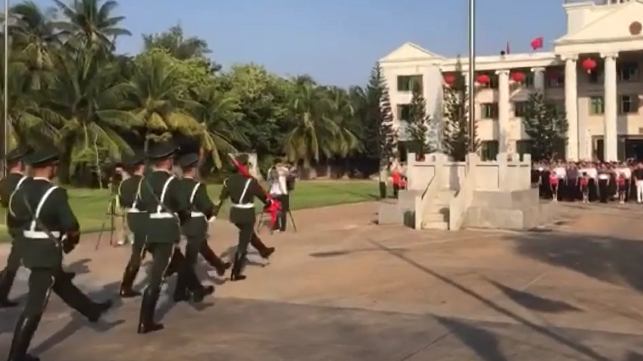China Expands its Political Control in the South China Sea

Over the past decade, China has earned itself a reputation as a bully in the South China Sea. Its relentless coast guard patrols, frequent maritime militia operations and regular naval deployments are well documented. Using these capabilities, China harasses foreign fishing boats, disrupts energy exploration attempts and otherwise prevents its Southeast Asian neighbors from operating safely in their own waters. With the recent passage of China’s new coast guard law, which authorizes the China Coast Guard (CCG) to use force more freely, this pattern of assertive behavior shows no signs of stopping.
Focusing exclusively on China’s use of coercion, however, obscures the true extent of Beijing’s ambitions. China’s campaign to dominate these contested waters is consequential, but its efforts to expand administrative capacity are equally significant. In recent years, China has invested heavily in building up new party-state institutions that are responsible for administering disputed areas. These institutions allow the Chinese Communist Party (CCP) to directly govern contested parts of the South China Sea as if they were Chinese territory.
This administrative build-up began in 2012 with the creation of Sansha City. The Ministry of Civil Affairs announced the State Council’s decision to found Sansha as a prefecture-level city in June 2012 and it was formally established a month later. The city is headquartered on Woody Island in the Paracel Islands and has jurisdiction over the Paracel Islands, Spratly Islands, Scarborough Shoal, Macclesfield Bank and the waters surrounding these features. It claims to govern approximately 2 million square kilometers of sea and land area.
Since 2012, Sansha City has overseen the development of China’s remote outposts in the South China Sea. Working with the authorities in Beijing, provincial officials in Hainan and other relevant parties such as the People’s Liberation Army (PLA), municipal leaders have pursued a wide range of infrastructure, transportation, telecommunications, economic development and defence projects on Woody Island and other occupied features.
For example, Sansha City has built new harbors, constructed seawater desalination facilities, invested in green energy, carried out land reclamation and anti-erosion work, expanded its population, established new maritime militia and maritime law enforcement forces and attracted investment from hundreds of companies. Sansha also created a military, law enforcement and civilian joint defence system to facilitate information sharing and joint operations between the PLA, maritime law enforcement forces and maritime militia forces.
Sansha City set up a large number of party-state institutions to oversee these initiatives and manage day-to-day affairs on the front lines of the South China Sea disputes. In addition to the numerous departments, bureaus and committees under the municipal party committee and government, the city now has two districts, four pairs of working committees and management committees, ten community resident committees, at least 70 grassroots party organizations and two pairs of courts and prosecution offices that answer to the municipal party-state.
These party-state institutions perform a number of important roles. They formulate and implement local policies, protect marine and island environments, procure goods and services from private and state-owned enterprises, manage transportation and logistics, uphold Chinese law, coordinate with the PLA and CCG and oversee the defence of China’s maritime claims. Perhaps most importantly, these party-state institutions ensure strong CCP political control over all activity on China’s far-flung bases in the South China Sea.
Sansha City’s working committees and management committees offer a clear example of this political control in action. Working committees are party institutions and management committees are corresponding state institutions. By mid-2015, Sansha had established four pairs of these committees with jurisdiction over Woody Island, the Crescent Group, the Qilian Islets and the Spratly Islands. These committees are in charge of organising maritime militia, law enforcement, emergency response, infrastructure construction and environmental protection work, among other responsibilities.
For instance, the Qilian Islets Working Committee and the Qilian Islets Management Committee oversee the localized defence of China’s maritime claims. Specifically, they manage a public security workstation, a border defence workstation, a comprehensive law enforcement workstation, a maritime militia command centre and a medical aid centre. The headquarters building for the Qilian Islets Working Committee and Qilian Islets Management Committee on Tree Island appears to be the site of Tree Island’s “informatized militia post,” which uses automatic identification system (AIS), radar and video surveillance to monitor nearby waters, feeding intelligence back to the authorities on Woody Island.
Similarly, the Crescent Group Working Committee and Crescent Group Management Committee use maritime militia and maritime law enforcement forces to implement local initiatives. In 2016, the Crescent Group Management Committee released a notice on the management of a nearby underwater sinkhole, prohibiting tourism, fishing and other similar activities within one nautical mile of the feature. The notice reportedly specified that the Crescent Group Management Committee is responsible for monitoring the area around the underwater sinkhole and coordinating the control of the area with law enforcement, militia and border defence personnel.
In this sense, Sansha City’s party-state institutions have real influence over China’s day-to-day operations in the South China Sea. Though observers often attribute every Chinese action in the South China Sea back to the leadership in Beijing, the city’s development shows how China’s control over these contested waters is becoming increasingly normalized, bureaucratized and localized.
Zachary Haver is the author of China Maritime Report No. 12: Sansha City in China's South China Sea Strategy: Building a System of Administrative Control.
This article appears courtesy of The Lowy Interpreter and may be found in its original form here.
The opinions expressed herein are the author's and not necessarily those of The Maritime Executive.
